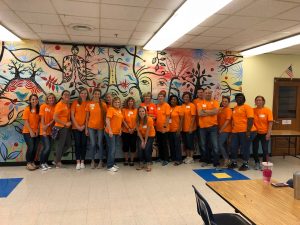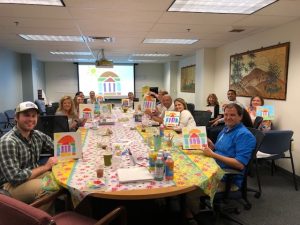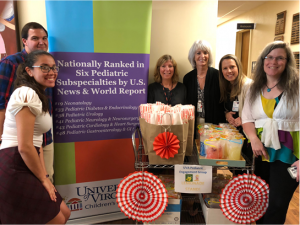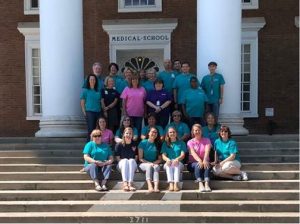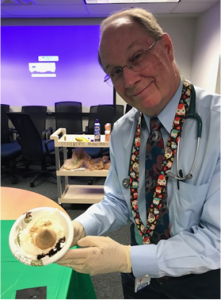By Liz Shifflett & Jessie Copeland
How a New Department Structure Created a Powerful Team: An interview with Liz Shifflett
Tell me about when you first started your position.
When I started this job two and a half years ago, I observed that we operate as 14 individual businesses, with over 100 faculty and over 100 staff members between the divisions. Because of these silos, there was limited: team building, best practice sharing, standard work, and process ownership.
On my first day, someone came to me and said, “How do I order a sign for the door?” I didn’t know how to do that. This person was disappointed and frustrated that the administration didn’t have an answer. I realized that it was my job to put a structure in place to make the answers easier for everyone.
Once you realized that changes needed to be made, where did you begin?
We focused on positive leadership and engagement and investing in the staff. We started a team-based initiative with administrative assistants.
The challenge we faced was that we had three administrative supervisors for over 100 staff, making it impossible to do work in a meaningful manner. Now, we have four teams, each with leads that supervise their team, which means the supervisors can focus on engagement and defining shared culture.
What was the next step?
After the administrative assistants, we began creating the same structure for education admin, specifically continuing medical education work. Now best practices are reaching across the departments – everyone is part of a team.
How did you implement this idea?
We knew we wanted to focus on continous improvement and engagement to boost workplace moral. We selected a shared competency across the department. This year, it was technical and professional knowledge.
From there, we created an incentive program. If team members attend staff meetings and trainings, they receive points. They can use these points for what works for them. Last year, we had about 40 team members that qualified for points and it was great to see the excitement.
How did you create the team feeling?
- Define Shared Values. We created a shared values statement for the staff. Here’s what we came up with: We strive to be resourceful, competent and responsible in all our daily work and interactions. We commit to nurturing a harmonious and respectful workplace by treating each other with encouragement, support and understanding every day.
- Demonstrate Value. We plan our staff meetings to show value – to reinforce the mission of the department and to be clear about the purpose of the meeting. We are helping save children’s lives, to improve health care forever. Having a dialog in these meetings is incredibly important.
- Have conversations. These conversations make everyone so aware! We collectively challenge each other. I want the team to define what they need then tell me what they need from me.
- Create Standard Work. We created standard policies in the department. Now, everyone knows the answer to how to order a door sign.
- Celebrate people. When I first started, I saw that we were celebrating team members when they were leaving. We want to invest in the people that stay. We now recognize employee anniversaries with a card. We give their manager a pool of money and they can get a cake and a little gift that is specialized for that person.
Why is continuous improvement so important?
We wanted to change the idea that when you need to improve, you’ve done something wrong. That’s not the case. We want feedback to improve and to be more efficient. In order to be successful, we have to create a culture of continuous feedback. Jessica Copeland has been pivotal in this work. She managed the entire competency program, handling the training and the points system. (See below for more about the program.)
What has been the most helpful part of this work?
I am most proud of the core administrative contact list. We surveyed the staff and asked them what they needed. From the survey answers, we identified an expert on topics the staff said were meaningful. This has cut down on unnecessary phone calls and time wasted – now everyone knows exactly where to go for answers.
Why are you passionate about this?
We have amazing people who are giving 100% every single day. Before, we didn’t have a structure to support their work. We have the right people, now we are helping them to create the best work product possible.
Shared Company Program: An interview with Jessie Copeland
How are competencies decided?
Each year, we choose a competency from the list provided on Lead@. We then create a learning system based around that particular competency, which the staff can work on throughout the year. To complete the program, each person must reach a certain number of points. The points are obtained by completing the different activities for that year’s program.
This year’s competency chosen was Technical/Professional Knowledge. “Is professionally and technically accomplished to perform one’s job. Achieves an accomplished level of technical and professional skill or knowledge in position-related areas; consistently staying abreast of current developments and trends in areas of expertise” With this in mind, we knew we wanted to integrate some technology based learning.
What ways can team members earn points?
To qualify, each person has to reach 10 points. Completing at least 1 training (4 pts) and attending at least 1 class (2 pts) was required. The remaining 4 points could be completed however the participant would like.
| Activity | # Points |
|---|---|
| Trainings (must complete at least one) Lynda.com | 4 |
| Classes (must attend at least one) | 2 |
| Books | 3 |
| Cheat sheets | 2 |
| Staff meeting | 1 |
Why is this program special?
I think that this is a wonderful program because it provides the staff trainings and classes that they may never have had the opportunity to participate in otherwise. It also introduces us to new benefits of being a UVA employee. A perfect example of this is Lynda.com. When we were creating this year’s Technical/Professional Knowledge competency, I stumbled upon Lynda.com. UVA employees have access to this website at no charge. The website has thousands of training videos of all different subjects. I have taken many classes on it so far and have learned so much.
How do you know the program is successful?
I know this program is working because I have staff members approaching me every week telling me how much they enjoyed attending one of the classes we included on the program, or something new they learned from a Lynda.com training. I had one person tell me they have completed many Lynda.com trainings now, not just because of the competency program, but because they enjoy learning new things!
What do you love most about this program?
Liz is so wonderful to credit me with this, but it was her idea! I have really enjoyed bringing new speakers and topics to the staff for the classes, and I love the Cheat Sheets section because it brings knowledge from the employees and allows us to share it with the rest of our over 100 staff members in our department! This not only helps the staff, but also strengthens our department by spreading the knowledge. A few weeks ago, I was trying to book a conference room. Because I am still relatively new to UVA, I did not know all of the rooms available or the contacts to reserve the rooms. One of our members came forward with a list she had of all of the conference rooms available to us at UVA and their locations along with who to contact for reservations. We were able to upload this to our shared O Drive folder, so now all of our 100 plus staff members have access to it!
What makes you passionate about this work?
I am passionate about this work because I think we have such wonderful and incredibly talented staff members in our department, and I love to see them enjoying the classes and being able to learn something new. It is so rewarding when someone comes up to me to tell me how much they enjoy the program. I think there is more to employment than just clocking in and putting your head down to work. Liz Shifflett has helped our department blossom by encouraging all employees to learn and grow.
Filed Under: Features

